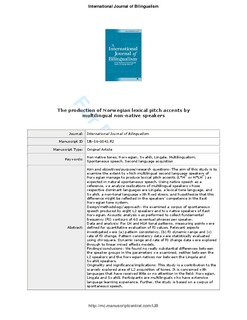| dc.contributor.author | Steien, Guri Bordal | |
| dc.contributor.author | van Dommelen, Wim A. | |
| dc.date.accessioned | 2017-01-26T09:58:37Z | |
| dc.date.available | 2017-01-26T09:58:37Z | |
| dc.date.created | 2016-11-14T16:11:04Z | |
| dc.date.issued | 2016 | |
| dc.identifier.citation | International Journal of Bilingualism. 2016, 1-14. | nb_NO |
| dc.identifier.issn | 1367-0069 | |
| dc.identifier.uri | http://hdl.handle.net/11250/2428540 | |
| dc.description.abstract | Aim and objectives/purpose/research questions: The aim of this study is to examine the extent to which multilingual second language (L2) speakers of Norwegian manage to produce lexical pitch accents (L*H ̄ or H*LH ̄) as expected in natural spontaneous speech. Using native speech as a reference, we analyse realizations of multilingual speakers whose respective dominant languages are Lingala, a lexical tone language, and Swahili, a non-tonal language with fixed stress, and hypothesize that this difference might be reflected in the speakers’ competence in the East Norwegian tone system.
Design/methodology/approach: We examined a corpus of spontaneous speech produced by eight L2 speakers and two native speakers of East Norwegian. Acoustic analysis was performed to collect fundamental frequency (f0) contours of 60 accentual phrases per speaker.
Data and analysis: For LH and HLH tonal patterns, measuring points were defined for quantitative evaluation of f0 values. Relevant aspects investigated were (a) pattern consistency, (b) f0 dynamic range and (c) rate of f0 change. Pattern consistency data were statistically evaluated using chi square testing. The dynamic range and rate of f0 change data were explored through to linear mixed effects models.
Findings/conclusions: We found no really substantial differences between the speaker groups in the parameters we examined, neither between the L2 speakers and the Norwegian natives nor between the Lingala and Swahili speakers.
Originality and significance/implications: This study is a contribution to the scarcely explored area of L2 acquisition of tones. It is concerned with languages that have received little or no attention in the field: Norwegian, Lingala and Swahili. Participants are multilinguals who have extensive language learning experience. Further, the study is based on a corpus of spontaneous speech | nb_NO |
| dc.language.iso | eng | nb_NO |
| dc.publisher | SAGE Publications | nb_NO |
| dc.title | The production of Norwegian tones by multilingual non-native speakers | nb_NO |
| dc.type | Journal article | nb_NO |
| dc.type | Peer reviewed | nb_NO |
| dc.source.pagenumber | 1-14 | nb_NO |
| dc.source.journal | International Journal of Bilingualism | nb_NO |
| dc.identifier.doi | 10.1177/1367006916673218 | |
| dc.identifier.cristin | 1400310 | |
| dc.relation.project | Norges forskningsråd: 223265 | nb_NO |
| dc.description.localcode | © The Author(s) 2016. This is the authors' accepted and refereed manuscript to the article. | nb_NO |
| cristin.unitcode | 194,62,60,0 | |
| cristin.unitname | Institutt for språk og litteratur | |
| cristin.ispublished | true | |
| cristin.fulltext | postprint | |
| cristin.qualitycode | 2 | |
